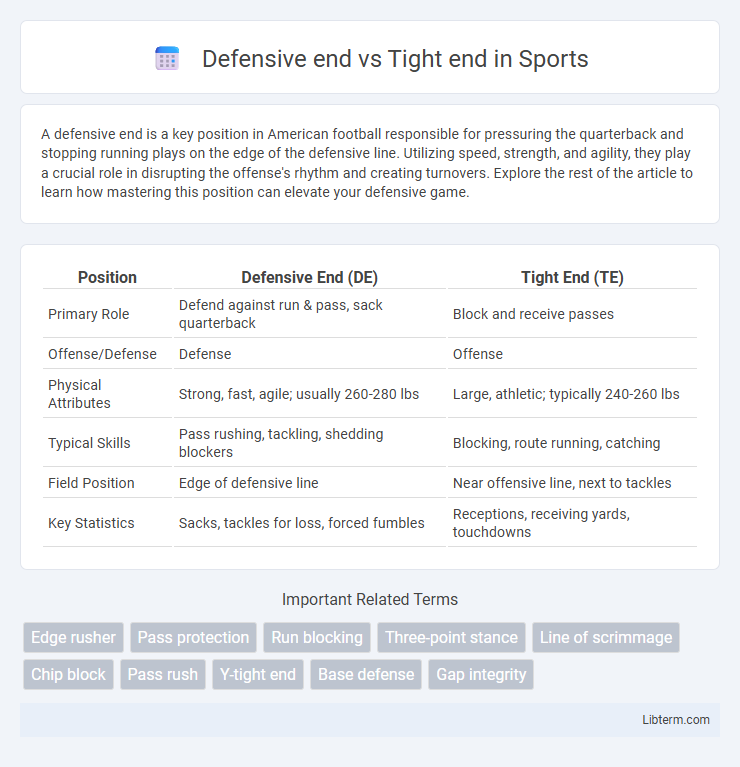A defensive end is a key position in American football responsible for pressuring the quarterback and stopping running plays on the edge of the defensive line. Utilizing speed, strength, and agility, they play a crucial role in disrupting the offense's rhythm and creating turnovers. Explore the rest of the article to learn how mastering this position can elevate your defensive game.
Table of Comparison
| Position | Defensive End (DE) | Tight End (TE) |
|---|---|---|
| Primary Role | Defend against run & pass, sack quarterback | Block and receive passes |
| Offense/Defense | Defense | Offense |
| Physical Attributes | Strong, fast, agile; usually 260-280 lbs | Large, athletic; typically 240-260 lbs |
| Typical Skills | Pass rushing, tackling, shedding blockers | Blocking, route running, catching |
| Field Position | Edge of defensive line | Near offensive line, next to tackles |
| Key Statistics | Sacks, tackles for loss, forced fumbles | Receptions, receiving yards, touchdowns |
Introduction to Defensive End and Tight End Positions
Defensive ends are key players in the defensive line, specializing in pass rushing and containing the edge against running plays to disrupt offensive drives. Tight ends combine the roles of receiver and blocker, positioned on the offensive line to support both passing and running strategies. Understanding the distinct responsibilities and physical demands of defensive ends and tight ends is crucial for evaluating player performance and game tactics.
Key Roles and Responsibilities
Defensive ends primarily focus on stopping the run and pressuring the quarterback by rushing the passer and containing outside runs on the defensive line. Tight ends serve a dual role as both blockers for the run game and receivers in the passing game, requiring a blend of size, strength, and agility. While defensive ends emphasize defensive disruption and tackling, tight ends act as versatile offensive players contributing to both passing and blocking schemes.
Physical Attributes and Athletic Requirements
Defensive ends require explosive power, agility, and speed to effectively rush the passer and contain the edge, typically possessing a combination of size, strength, and quick reflexes. Tight ends combine size and strength similar to offensive linemen with the speed and agility of wide receivers to block effectively and run precise routes for receiving. Both positions demand exceptional conditioning, but defensive ends prioritize rapid bursts and tackling ability, while tight ends emphasize versatility in athleticism for both blocking and pass-catching.
Positioning on the Field
Defensive ends line up on the outer edges of the defensive line, primarily tasked with rushing the passer and containing the run on the edge. Tight ends position themselves next to the offensive tackles, serving a dual role in blocking and receiving within the offensive formation. Their alignment near the offensive line allows tight ends to exploit mismatches against linebackers and defensive backs.
Skills and Techniques Required
Defensive ends require explosive strength, speed, and agility to rush the quarterback and contain running plays, relying heavily on hand-fighting techniques and quick footwork to shed blocks. Tight ends need versatile skills, combining offensive lineman blocking techniques with precise route-running, reliable catching ability, and strong hands to contribute both in the passing and running game. Mastery of leverage and positioning is critical for defensive ends, while tight ends emphasize route precision and defensive reading to create separation and secure receptions.
Training and Conditioning Differences
Defensive ends focus on explosive strength, agility, and lateral quickness to penetrate offensive lines and pursue quarterbacks, requiring rigorous speed drills and resistance training. Tight ends emphasize a combination of strength, blocking technique, and route running agility, necessitating a balance of weight training and precise footwork exercises. Conditioning for defensive ends prioritizes power and endurance for repeated high-intensity bursts, while tight ends develop muscular endurance and cardiovascular fitness to maintain performance across offensive plays.
Offensive vs Defensive Mindset
Defensive ends focus on penetrating the offensive line with a mindset geared toward disrupting plays and tackling ball carriers, emphasizing agility, strength, and quick decision-making to pressure quarterbacks and stop runs. Tight ends adopt an offensive mindset blending blocking skills with pass-catching abilities, requiring versatility to protect quarterbacks and create receiving options. Both positions demand specialized techniques but differ fundamentally in their strategic objectives: defensive ends prioritize containment and disruption, while tight ends balance support and offensive advancement.
Notable Players in Each Position
Notable defensive ends like J.J. Watt and Aaron Donald have set standards for pass rushing and run defense with multiple MVP and Defensive Player of the Year awards. On the other hand, tight ends such as Tony Gonzalez and Travis Kelce are renowned for their exceptional receiving skills and ability to create mismatches in the passing game. Both positions demand unique athletic attributes, with defensive ends excelling in strength and speed while tight ends combine blocking prowess with reliable catching ability.
Impact on Game Strategies
Defensive ends primarily disrupt offensive plays by pressuring the quarterback and containing runs, forcing offenses to adjust blocking schemes and increase quick passes. Tight ends serve dual roles as blockers and receivers, creating versatile offensive formations that complicate defensive coverages and open up play-action opportunities. The strategic interplay between defensive ends and tight ends influences tempo control and the balance between rushing and passing attacks.
Choosing the Right Position for Athletes
Defensive ends excel with strength, agility, and quick reflexes to pressure quarterbacks and stop running backs, making them ideal for athletes with explosive speed and powerful tackles. Tight ends require a unique blend of blocking prowess and reliable hands for catching passes, suitable for players who combine size, agility, and good route-running skills. Assessing an athlete's physical attributes, skill set, and play style is crucial when choosing between defensive end and tight end positions to maximize performance and team impact.
Defensive end Infographic

 libterm.com
libterm.com